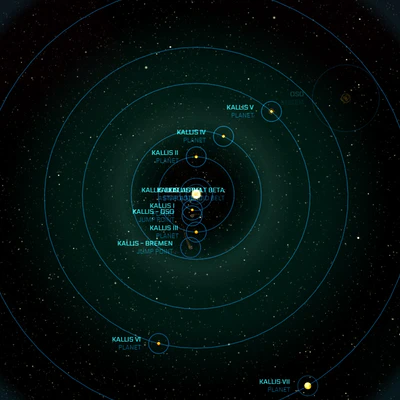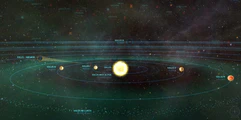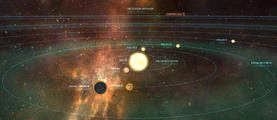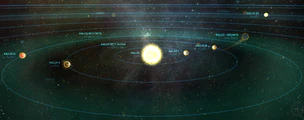Quick facts:Kallis system
The Kallis system is a whirling mass of potential, the recently discovered system has excited scientists and researchers the United Empire of Earth (UEE) over by offering them a rare opportunity: to witness the formation of a stellar system first hand. Kallis was first visited in 2921 through its jump point connection with Oso, and initial Imperial Cartography Center (ICC) scans of the system revealed a G-class main sequence star anchoring nine protoplanets in various stages of development. Officially, the system's discovery is credited in the records to OB Station Chimera, the main research facility in Oso, but many still persist that it should be rightly attributed to former PFC Gabby Rifon. Part of the Army security force detailed under the Fair Chance Act to protect Oso II from poachers, smugglers and other trespassers, Rifon served as a long range scan technician tasked with sweeping the system for any errant ships. According to later interviews, Gabby was often "bored as hell" looking for ships hours at a time. Instead she would shrug off her duties and adjust the scan station to search for spatial anomalies. It was during one such unauthorized session that Gabby excitedly noted faint indications of a jump point. Informing her commanding officer of the discovery brought to light the fact that Gabby had been "wasting" hours during her shift. A week before the first ship would traverse the Oso - Kallis jump point, Gabby was dishonorably discharged for improper use of Army resources.
Almost immediately it was clear that Kallis, meaning "beloved" in a Martian dialect, was a system to be cherished. Once again, Humanity was getting a chance to witness the birth of a solar system firsthand, and scientists around the Empire pledged to not let the opportunity be squandered as it had been in Gurzil. When Gurzil, a system still in its accretion phase, was discovered in 2539, scientific access was cut short due to security concerns. Upon the arrival of Xi'an ships in 2542, Gurzil was drafted into the UPE's recently created Perry Line and set aside to protect Humanity's borders. For the next several centuries, the system was off limits to everyone but military forces. Upon the dissolution of the Perry Line, the scientific community had hoped that Gurzil would fall under the protection of the Fair Chance Act. However, various industries lobbied that the military's centuries of intervention had already damaged the system past its original scientific value and that it would better serve the credit-strapped Empire by allowing the harvest of its valuable resources. In the end, the Senate voted against applying the Fair Chance Act to Gurzil and decided to allow both research and restricted mining in the system. The scientific community was strongly motivated to make Kallis a different story.
Within a month of the first scan report from Kallis being released, a bill was introduced on the Senate floor to place the system under the protection of the Fair Chance Act and, this time around, thanks to the pristine status of the system as well as a much more favorable Transitionalist-controlled chamber, the vote passed. The system at once became off-limits to commercial development and general traffic. From that point on, Kallis would be a sanctuary for research and discovery. Under the guidance of a joint Army and Imperial Science and Technology Foundation governing body, the past two decades have already greatly expanded our knowledge and understanding of the universe around us. Undoubtedly, this is just the start of a trend that will continue for decades to come as research continues in Kallis around the clock and new generations of scientists eagerly await their turn to study nature's mysteries first hand.[1]
"I learned a ton during my two years in Kallis. Unfortunately, I forgot most of it thanks to my two years visiting Gryphon."
Dr. Wahid Allimon, Professor of Geology, University of Rhetor, 2945[1]
Kallis is a system still in its infancy. All the planetary masses are still forming and cooling. It's not ideal for colonists and with the exception of some rare metals in unusual concentrations it's not great for merchants… but all eyes are on the system in the scientific community. As such, the system has no native population or representation in the UEE senate; it is officially governed by a panel of Imperial researchers.
Kallis IV, survey number DXP-55.7c, has attracted particular attention because of its believed similarity to Earth at this stage of a star system's formation. Survey teams are observing the planet from the edge of the system with orbital stations and spy-eye recon drones twenty-three hours a day and the work is less than thrilling. The potential for studying how an Earth-like planet is formed is exciting, but all parties involved know that it will take tens of thousands of years to gather the necessary data. Black market traders might be advised that the crews manning these posts will be looking for other forms of entertainment to fill their days.
Kallis' 7th planet, a gas giant, has been identified as a potential refueling station, although only a small Lagrange platform currently exists there (not on the Starmap). The belief is that Kallis may become a jump hub as expansion into this region of the galaxy continues; canny real estate investors would be advised to purchase land deeds immediately.[2]
"Even though my mom didn't get the credit she deserved for discovering the system, there is some small consolation in that they named that station after her. Sure, if you ask they'll say it's named for one of those lion-bird things, but come on, it's pretty clear that the scientists in charge were sticking it to those Army guys when they chose the name."
Alice Thomas, daughter of Gabby Rifon, 2943[1]
Travel warning
All ships arriving in system are expected to first stop at OB Station Gryphon to officially register. Traveling anywhere without having acquired the proper clearance is a sure way to draw the ire of the Army pilots on patrol here.[1]
Gravitational governors
Kallis
Kallis is a G-type main sequence star.
Planets
Kallis I
A small mass believed to be developing into a protoplanet. Protected under the Fair Chance Act.
Kallis II
A rocky terrestrial world forming between two asteroid belts. Currently shares an orbit with Kallis III. Protected under the Fair Chance Act.
Kallis III
Sharing the same orbital path as Kallis II, scientists are eagerly watching and wondering if one of the planets will subsume the other. Protected under the Fair Chance Act.
Kallis IV
A world dominated by volcanic activity that appears to be forming an atmosphere. Members of the scientific community are particularly fixated on Kallis IV, survey number DXP-55.7c, and track its progress from the edge of the system with orbital platforms and research drones, hoping it might reveal how Earth developed. Protected under the Fair Chance Act.
Kallis V
A rocky terrestrial planet without an atmosphere. It is believed that a massive meteor strike created the accretion disk swirling around this world. The coalescing debris has some scientists hypothesizing that the disk may form into a moon. Protected under the Fair Chance Act.
Kallis VI
A forming terrestrial, carbon planet still early in its development. Protected under the Fair Chance Act.
Kallis VII
Scientists are watching this burgeoning gas giant's atmosphere closesly to study storm formations. Protected under the Fair Chance Act.
Kallis VIII
Witnessing the formation of this ice giant is of great interest to the scientific community as there are still debates as to the exact process. Composed of heavier elements than normal gas giants, it is currently believed that Kallis VIII formed closer to the star before being gravitationally scattered outward to its current orbit. Protected under the Fair Chance Act.
Kallis IX
This small dwarf planet's surface is a barren icy tundra dotted with active cryovolcanoes that spew freezing magma into the tumultuous ammonia-rich atmosphere. Scientists theorize that Kallis IX will slowly grow dormant over the next few millennia. Protected under the Fair Chance Act.
Asteroid belts
Belt Alpha
As the gravity wakes from the nearby forming worlds tug at this dense orbiting collection of planetesimal, frequent collisions can cause chaotic motion and hazardous travel conditions anywhere nearby. Located between the orbits of Kallis I and Kallis II/III.[1]
Belt Beta
A swirling mass of asteroids and dust grains, this belt is composed of materials with high melting points. Although there is enough mass here to compose three to five planets, orbital resonance with the surrounding worlds has prevented this from happening yet. Located between the orbits of Kallis II/III and Kallis IV.[1]
Kallis V Accretion Disk
Accretion disk sorrounding Kallis V.
Space stations
OB Station Gryphon
An observation post for scientists studying the developing system. Located near the Kallis - Oso Jump Point.
Known jump points
| Jump gate | Direction | Size | Destination |
|---|---|---|---|
| Kallis - Bremen | Bidirectional | Large | Bremen - Kallis, in Bremen system |
| Kallis - Oso | Bidirectional | Large | Oso - Kallis, in Oso system |
Gallery
Loremaker's Guide to the Galaxy
References
- ↑ Jump up to: 1.0 1.1 1.2 1.3 1.4 1.5 Galactic Guide: Kallis System, Jump Point, vol. 05, no. 02.
- ↑ Unlock: Kallis System. Transmission - Comm-Link
- ↑ Comm-Link:Loremaker's Guide to the Galaxy - Kallis System. Transmission - Comm-Link



